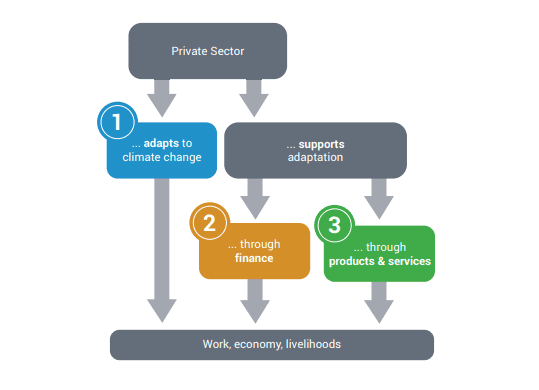Context
Climate change has severe effects on the private sector. It is estimated that climate change could add over USD 100 billion of loss each year to the global economy, resulting in indirect costs from supply chain disruption and other knock-on economic consequences4. The first role of the private sector is thus to adapt its own assets, operations, supply chains, and resources to the impacts of climate change to ensure business continuity and sustainable economic growth.
How is the private sector impacted by climate change?
Rising sea levels, temperatures, and more frequent extreme weather events, such as droughts, floods and wildfires and other climate change impacts threat business assets, supply chains and operations more and more frequently. Climate-induced risks vary between sectors and are determined by an enterprise’s direct exposure to those hazards. At the same time, such risks are also determined by their vulnerabilities, which can be can contextually defined as resource dependency.
What are the challenges of the private sector to adapt to climate change?
The private sector consists of various actors, ranging from large multinational enterprises to individual business owners and other non-governmental agencies, who regardless of their size and sector need to adapt to the widely felt impacts of climate change. However, this happens in different degrees and timelines depending on their respective vulnerabilities to direct and indirect climate-induced risks. A company’s size and financial resources are important factors for determining their capacity to adapt to climate change. Besides, limited resources pose further challenges for private sector adaptation as they prevent investing in adaptation measures to counter extreme weather occurrences and slow-onset events. Such resource limitations inter alia include a lack of awareness of climate and disaster risks, as well as limitations to available solutions.
How can the private sector adapt to climate change?
Private sector adaptation to climate change aims to minimize climate-induced risks in order to increase the resilience of businesses and to avoid potential future costs. Managing climate risks thus should be embedded into corporate risk management. By improving their adaptive capacity and by implementing adaptation measures, vulnerability to climate-induced risks and related negative effects on businesses can be reduced.
Examples
Companies will first focus on adaptation within their direct sphere of influence. This can include measures to improve company buildings and infrastructure, the production process, the situation of employees or the storage of supplies and produced goods. Collaboration on adaptation with external stakeholders, such as suppliers, buyers, governmental authorities or the financing community is more challenging.
Which adaptation measures a company chooses depends on the climate change impacts and risks it faces. These are dependent on the company’s location, sector, technology level, and adaptive capacity. Deciding factors include investment costs for measures, the type of risk covered, the comprehensiveness of the measure and, whether there are (positive or negative) side effects to be expected.
See the Climate Expert Website for case studies from Bangladesh, Costa Rica, Morocco, Nicaragua and Rwanda
Examples for adaptation measures to minimize risks include:
- Installation of power backups for uninterrupted power supply in the case of interruption due to storms
- Usage of water saving technologies in order to cope with water shortages
- Installation of weather-proof storage spaces for protecting valuables against extreme weather events
- Provide housing for employees on the company’s premises to ensure that they can reach the company even during heavy rains or extreme heat
- Diversify suppliers to reduce price increases and transport interruptions during extreme weather events
- Assess whether and how to invest in solar panels for independent energy generation
How can the private sector be supported in adapting to climate change?
Climate change adaptation requires a thorough understanding of the potential impacts of climate change and how buildings, operations, (human) resources and the overall strategy of a company are likely to be affected. There are different approaches that can serve companies to assess those risks. Tools usually encompass an exposure assessment to climate-related risks, as well as an assessment of each potential climate hazard’s impact on the company to identify and prioritize possible adaptation measures. By defining several standard impact areas to be analyzed by these tools, such as the company’s buildings, its processes, its logistics and stock, employees, the regulatory framework, access to finance and market demand, these assessments can be implemented in a structured way for each company. Cost-benefit tools or similar decision-making instruments can further support companies’ decision on the most beneficial adaptation measures. Visit our Webpage Climate Risk Assessment & Management for more details.


